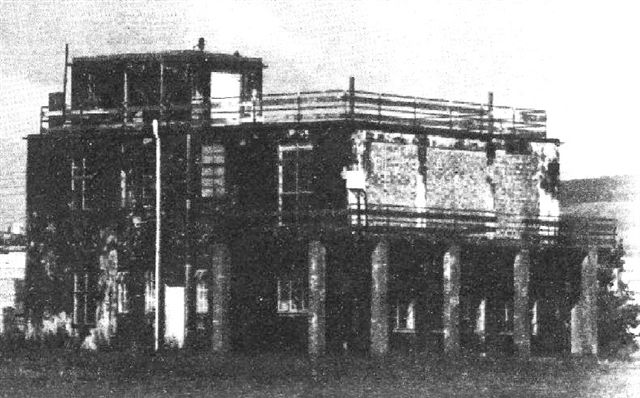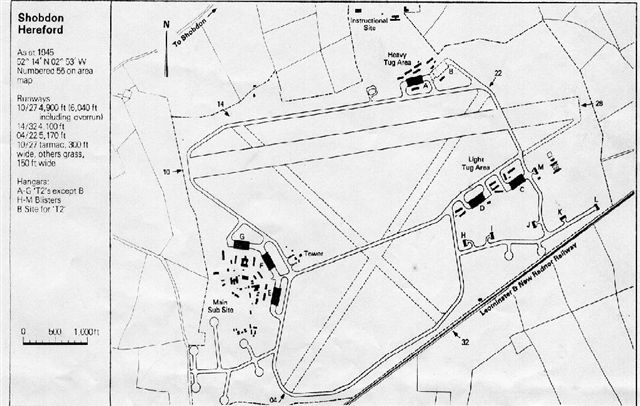![]()
Shobdon Airfield

Website for members of the former Hereford Parachute Club
This website was created on August 10, 2003.
To view photographs of Shobdon as it is today, then click on the link below
____________________
This article is reproduced from Action Stations 3, The Airfields. A photocopy was given to me sometime ago and as I do not know, I am unable to give full credits to the author and I apologise.
The evening of September 16, 1943 was a disastrous one for the VIII Air Force groups raiding western France. Bad weather on the return trip scattered the bomber force all over South West England and the Darkie frequency (an emergency homing system) was alive with calls for assistance. Three Fortresses crashed into high ground in Devon and South Wales but most of the others managed to put down at any RAF field they could find. One Fort crew flying on three engines was relieved to find a long runway out in the middle of nowhere and landed on it with almost dry tanks after 10 and a half hours in the air. A month later an American Thunderbolt pilot did the same thing when he got completely lost on the way back home after a mission.
The airfield they found was built in a very isolated area which made it ideal for glider training as there were no other aerodromes near enough to interfere with local flying. The site had been used for flying since 1940 under the name of Pembridge Landing Ground, after another neighbouring village. Fairey Battles and Lysanders belonging to 8 AACU operated from from here in support of Army manoeuvres and it was decided to develop it as a proper airfield. During the construction the aircraft moved elsewhere but returned in June 1942, dividing their time between here and Madley until at least the middle of 1944. By this time the detachment had become part of 577 Squadron and was now equipped with Martinets and Oxfords.
This is the old control tower, destroyed by an act of vandalism of developers who put money before history and the sacrifices made by the men who went to war from this airfield.
The first visitor after the new airfield opened on May 28, 1942 was a Grumman Martlet which forced-landed whilst on a flight from Yeovilton to Donibristle on June 20. A few days later two Canadian Spitfires landed after getting lost on a cross-country flight. On July 14 the first aircraft to be based - a Lysander - was delivered by an ATA pilot, followed by two dismantled Hotspur gliders brought by road. The rest of 5 Glider Training School had arrived by July 30 from Kidlington and training was resumed almost immediately. The local people soon became used to the novel sight of labouring Miles Masters towing Hotspurs overhead the airfield, clawing for a little height before casting them off. Tractors were in short supply but they were augmented by cart-horses which dragged the gliders back to the end of the runway so that they could be hitched up to the tow-planes again. A runway three times wider than normal helped immensely because a glider/tug combination could be marshalled to one side whilst traffic landed on the other half.
A detachment of Bostons from 88 Squadron was based in July 1943 for smoke-laying demonstrations, and December of the same year saw a call for an accelerated output of glider pilots in preparation for the coming invasion of Europe. Unfortunately Shobdon's grass surfaces on which the gliders usually landed were muddy and unserviceable and half the runway width was unusable because of re-surfacing work. The Glider Instructor Flight was therefore detached to operate from the RLG at Hockley Heath near Solihull in Warwickshire. The RLG was promoted to full satellite of Shobdon on May 22, 1944 but difficulties were experienced there with rough ground, particularly when landing at night.
Accidents were relatively few but one, on the night of February 25, 1944, led to Warrant Officer G. Woodson being awarded the Air Force Cross for his gallantry. Woodson was a pilot of a Hotspur whose Master tug suffered engine failure, released the tow rope and crashed. he forced-landed in the dark near the burning Master and managed to rescue one of the occupants. An unusual incident occurred on October 12, 1944 when a tug combination was struck by lightening . The glider got out of control but one of the two occupants bailed out in time, the other being killed in the ensuing crash.
Plan of airfield.
Sommerfield Track was laid to improve the airfield surface and a renewed training effort was made to replace the heavy losses of glider pilots at Arnhem. There was a surplus in the spring of 1945, however, and, by September, 5GTS was a shadow of its former self although still able to send a Master/Hotspur combination via Croughton for a demonstration at the Hendon, Battle of Britain display. It was also able to perform at another display at Tilstock in Shropshire.
During November 1945, 23 Hotspurs and 23 Masters were flown to Montford Bridge for breaking up by 34 MU and, by the end of the month, the school had disbanded. This peaceful corner of Herefordshire had trained 1,335 glider pilots, 191 gliding instructors and 280 tug pilots. The airfield now became a detached site of 26MU at Hartlebury, a ground station between Kidderminster and Worcester.
Shobdon was unused by aircraft until the early 1960's when light aircraft began to operate from here as there was no other available aerodrome for miles. The usual lack of capital has prevented it from expanding and the huge runway is only partly usable, as most of it has deteriorated badly. One of the wartime 'T2' hangars is still in use and a small control building has been put up. Many of the original huts remain in various stages of decay and the old tower, a large 518/40, still stands derelict (not any more) on the south-west boundary where the main site with its three 'T2's was once located. The centre of activity today is in what was known as the Heavy Tug area on the north-est side of the field. The Light Tug area was in the south-east corner with two more 'T2's and six blister hangars on a loop dispersal. The provision of a canon range and a Battle HQ makes one to speculate that the airfield was intended for more war-like purpose than glider training, but the only operational unit which ever used it was a brief detachment of 88 Squadron mentioned above.
It achieved a certain notoriety among private pilots because there were no navigation aids until 1970 when a Non-Directional Beacon was installed and there are no prominent geographical features to help locate the airfield from the air. Nevertheless there have been many excellant displays and air races staged here. On one occasion a USAF C-123 Provider flew members of the US Army's Special Forces from Sembach in Germany on a liaison visit to their opposite numbers, the Special Air Service, at Hereford. Another interesting aircraft is a Howard 500, a modernised Lockheed Ventura.
____________________
![]()

I would welcome any information or photo's that anyone could send to me about the club during the years that it operated.
Have you got a story about the club or any of its members? to tell? Please send them to me, although in some cases I may have to edit them a bit!

